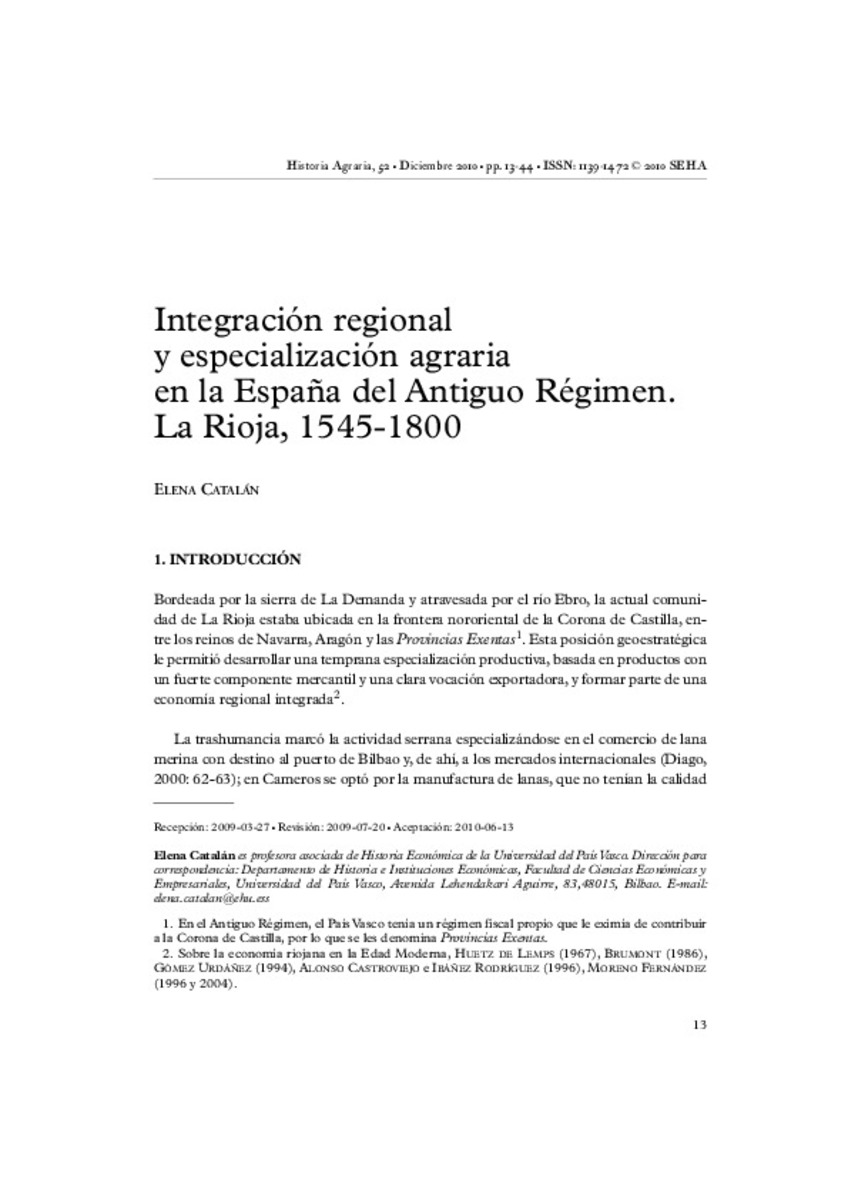| dc.contributor.author | Catalán Martínez, Elena | |
| dc.date.accessioned | 2016-02-08T11:16:00Z | |
| dc.date.available | 2016-02-08T11:16:00Z | |
| dc.date.issued | 2010-12 | |
| dc.identifier.issn | 1139-1472 | |
| dc.identifier.uri | http://hdl.handle.net/10234/148965 | |
| dc.description.abstract | Durante el siglo XVI, La Rioja formó parte de los circuitos comerciales del Atlántico-Norte, lo que favoreció una economía muy diversificada para la época. A través de la contabilidad eclesiástica, este trabajo establece la evolución del producto agrario regional, el tempo y la intensidad de los ajustes en el campo riojano y en qué medida fueron impulsados por la demanda. La evolución de la producción agraria riojana muestra dos modelos de crecimiento complementarios: en las comarcas occidentales, la demanda de los mercados internacionales y urbanos sobre la lana y el vino fue determinante; mientras, en el oriente riojano la presión de la población sobre la capacidad productiva se manifestó de manera más contundente, evidenciando los límites de una agricultura tradicional. En el conjunto de la economía regional, las áreas con diversificación productiva obtuvieron mejores resultados en el largo plazo que aquellas donde dominó un único cultivo. | ca_CA |
| dc.description.abstract | In the sixteenth century, the Rioja region was part of the North Atlantic trade routes. This
encouraged an economy very diverse for the time. Using ecclesiastical accounting sources, this paper establishes the evolution of the regional agrarian product, the speed and the intensity with which the changes in the Rioja countryside came about and to what extent they were a result of the demand. The evolution of agricultural production in the Rioja region highlights two complimentary models of growth: in the western areas, demand in international and urban wine and wool markets was a determining factor, while in the east, population pressures played a greater role underlining the limits of traditional agriculture. Within the regional economy, the areas which were able to maintain a certain degree of diversification of production gained better results in the long term than those areas which remained faithful to a single crop. | ca_CA |
| dc.format.extent | 32 p. | ca_CA |
| dc.format.mimetype | application/pdf | ca_CA |
| dc.language.iso | spa | ca_CA |
| dc.publisher | Sociedad Española de Historia Agraria (SEHA) | ca_CA |
| dc.relation.isPartOf | Historia agraria: Revista de agricultura e historia rural, nº 52, p. 13-44 | ca_CA |
| dc.rights | 2010 SEHA | ca_CA |
| dc.rights.uri | http://rightsstatements.org/vocab/InC/1.0/ | * |
| dc.subject | especialización agraria | ca_CA |
| dc.subject | integración regional | ca_CA |
| dc.subject | vino | ca_CA |
| dc.subject | cebada | ca_CA |
| dc.subject | Edad Moderna | ca_CA |
| dc.subject | agrarian specialization | ca_CA |
| dc.subject | regional integration | ca_CA |
| dc.subject | wine | ca_CA |
| dc.subject | barley | ca_CA |
| dc.subject | Ancient Regime | ca_CA |
| dc.title | Integración regional y especialización agraria en la España del Antiguo Régimen. La Rioja, 1545-1800 | ca_CA |
| dc.type | info:eu-repo/semantics/article | ca_CA |
| dc.subject.jel | R11 | ca_CA |
| dc.subject.jel | N53 | ca_CA |
| dc.subject.jel | N93 | ca_CA |
| dc.subject.jel | O13 | ca_CA |
| dc.rights.accessRights | info:eu-repo/semantics/openAccess | ca_CA |
| dc.relation.publisherVersion | http://historiaagraria.com/info_articulo.php?id=525 | ca_CA |







